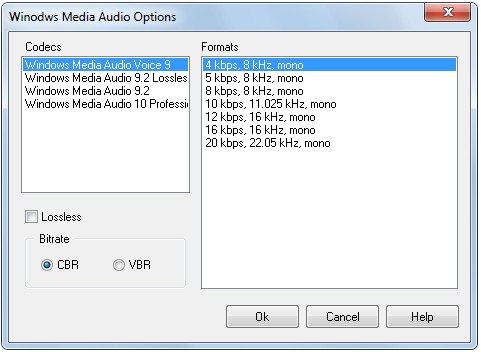Windows Media Audio (wma) is an audio data compression technology developed by Microsoft. The name can be used to refer to its audio file format or its audio codecs. It is a proprietary technology that forms part of the Windows Media framework. WMA consists of four distinct codecs. The original WMA codec, known simply as WMA, was conceived as a competitor to the popular MP3 and RealAudio codecs. WMA Pro, a newer and more advanced codec, supports multichannel and high-resolution audio. A lossless codec, WMA Lossless, compresses audio data without loss of audio fidelity (the regular WMA format is lossy). WMA Voice, targeted at voice content, applies compression using a range of low bit rates.

Windows Media Audio (WMA) is the most common codec of the four WMA codecs. Colloquial usage of the term WMA, especially in marketing materials and device specifications, usually refers to this codec only. The first version of the codec released in 1999 is regarded as WMA 1. In the same year, the bit stream syntax, or compression algorithm, was altered in minor ways and became WMA 2. Since then, newer versions of the codec were released, but the decoding process remained the same, ensuring compatibility between codec versions. WMA is a lossy audio codec based on the study of psychoacoustics. Audio signals that are deemed to be imperceptible to the human ear are encoded with reduced resolution during the compression process.
WMA can encode audio signals sampled at up to 48 kHz with up to two discrete channels (stereo). WMA 9 introduced variable bit rate (VBR) and average bit rate (ABR) coding techniques into the MS encoder although both were technically supported by the original format. WMA 9.1 also added support for low-delay audio, which reduces latency for encoding and decoding.
Fundamentally, WMA is a transform coder based on modified discrete cosine transform (MDCT), somewhat similar to AAC, Cook and Vorbis. The bit stream of WMA is composed of superframes, each containing 1 or more frames of 2048 samples. If the bit reservoir is not used, a frame is equal to a superframe. Each frame contains a number of blocks, which are 128, 256, 512, 1024, or 2048 samples long after being transformed into the frequency domain via the MDCT. In the frequency domain, masking for the transformed samples is determined, and then used to requantize the samples. Finally, the floating point samples are decomposed into coefficient and exponent parts and independently huffman coded. Stereo information is typically mid/side coded. At low bit rates, line spectral pairs (typically less than 17 kbit/s) and a form of noise coding (typically less than 33 kbit/s) can also be used to improve quality.
Like AAC and Ogg Vorbis, WMA was intended to address perceived deficiencies in the MP3 standard. Given their common design goals, the three formats ended up making similar design choices. All three are pure transform codecs. Furthermore the MDCT implementation used in WMA is essentially a superset of those used in Ogg and AAC such that WMA iMDCT and windowing routines can be used to decode AAC and Ogg Vorbis almost unmodified. However, quantization and stereo coding is handled differently in each codec. The primary distinguishing trait of the WMA Standard format is its unique use of 5 different block sizes, compared to MP3, AAC, and Ogg Vorbis which each restrict files to just two sizes. WMA Pro extends this by adding a 6th block size used at 88.2/96 kHz sampling rate.
Certified PlaysForSure devices, as well as a large number of uncertified devices, ranging from portable hand-held music players to set-top DVD players, support the playback of WMA files. Most PlaysForSure-certified online stores distribute content using this codec only. In 2005, Nokia announced its plans to support WMA playback in future Nokia handsets. In the same year, an update was made available for the PlayStation Portable (version 2.60) which allowed WMA files to be played on the device for the first time.
|
Copyright (c) 2013 AudioDope team. All rights reserved.
|
|
What do you think about this topic? Send feedback!
|